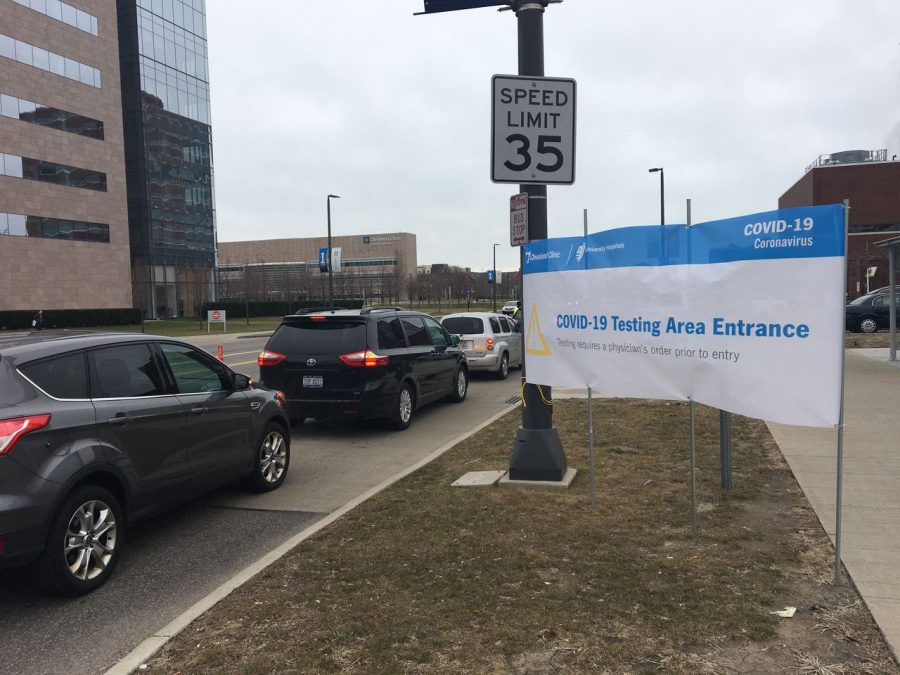Cleveland hospitals develop new COVID-19–testing procedures amid limited resources
Just one day after the World Health Organization’s urgent declaration of a global pandemic, Dr. Amy Acton, Director of the Ohio Department of Health (ODH), estimated that over 100,000 Ohioans were carrying the virus; however, the official number of cases in the state is only 169, as of March 20. If Acton’s estimate is true, approximately 1% of the state’s population carries the virus, meaning much of the state is vulnerable to community transmission and contracting COVID-19. But, why the large discrepancy between the number of confirmed and estimated cases?
Ohio, along with the rest of the United States, is facing a major backlog of COVID-19 test kits from the Center for Disease Control and Prevention (CDC). As of March 6, only 2,000 U.S. residents had been tested for COVID-19. This delay prompted the ODH to prioritize certain groups for testing, including those who display COVID-19 symptoms, healthcare workers, people with preexisting conditions and the elderly.
Even as Ohio is receiving more kits from the CDC, the testing process continues at a sluggish place, according to Acton.
Stemming from a myriad of manufacturing issues and underfunding, this shortage has made it difficult for public health officials to understand COVID-19’s reach.
“Our delay in being able to test has delayed our understanding of the spread of this,” Acton said.
Thus, public health officials are often left in the dark, with very little data they can rely on to understand the crisis and make decisions. All the while, cases in the US have surpassed 15,000 and continue to pour in at an exponential rate.
Uncertainty hangs over Cleveland, in particular, where an estimated 12,000 infected residents remain undiagnosed. That’s why two area hospitals have started a new initiative to get more Clevelanders tested.
On Saturday, March 14, lengthy lines of cars snaked their way along Carnegie Avenue as healthcare workers in blue gowns swabbed patients in their cars. All the while, white cars transported samples to laboratories around the city.
This was the first day of a new joint effort between Cleveland Clinic and University Hospitals (UH). After one day of testing, five new cases of COVID-19 were discovered as a result of these efforts.
Cleveland Clinic and UH started this drive-thru COVID-19 testing program to further streamline testing. Patients can get tested in two locations: W.O. Walker Building (10524 Euclid Avenue, Cleveland, OH) or UH Landerbrook Health Center in Mayfield Heights. Cleveland Clinic started testing patients at 11 a.m. on Saturday, March 14. UH started testing on Monday at 11 a.m. Both drive-thrus are open seven days a week from 11 a.m. to 7 p.m. and are free.
In order for patients to participate, a doctor’s order is needed. Individuals can consult Cleveland Clinic’s Express Care Online to see if they are eligible for the drive-thru. There, they will receive a medical screening to determine if the test is needed. This consultation appointment may come with additional charges.
If a test is needed, Cleveland Clinic and UH’s process is quite straightforward. Patients wait in a line of cars separated by orange cones. They remain in their car and present their doctor’s orders. Once verified, healthcare professionals in full protective gear administer swabs while the patient is seated in the car. Patients can drive away after being swabbed.
“We will essentially be performing the same test that’s used by the [CDC] after we complete our validation process,” Andrea Pacetti, a Cleveland Clinic spokesperson, told The Plain Dealer.
The test released by Cleveland Clinic and UH will be more efficient than the CDC’s test, however, as their in-house test will only take eight hours for results to come back. In contrast, the test from ODH took 24 to 48 hours to return. The new test would allow for a faster diagnostic turnaround and allow more Clevelanders to be tested. Even with the new drive-thru efforts, the effects of the testing delay will remain, though.
“The entire health care community is coming together by responding with tremendous unity, everyone is looking at us to do what is right, and we will,” said Dr. Tomislav Mihaljevic, President and CEO of the Cleveland Clinic. “We are working together to optimize our preparations by standing together as a team to meet the demands of our patients, our families and our communities.”

Collin Wong is a fourth-year majoring in biochemistry. He is from Washington, D.C. Outside of The Observer, he enjoys writing for his blog, eating ramen...


